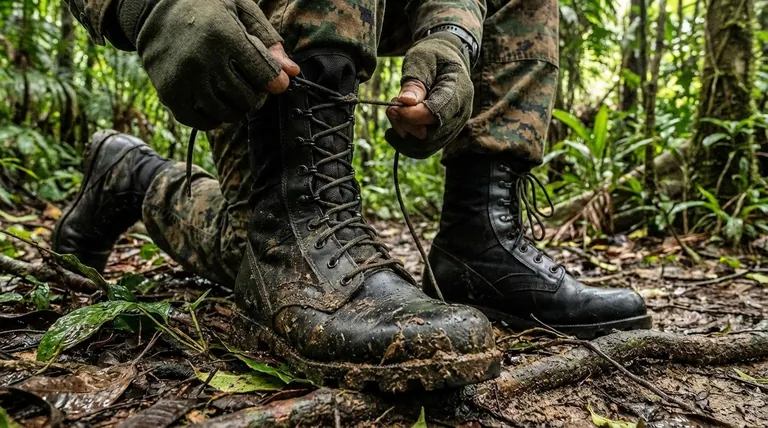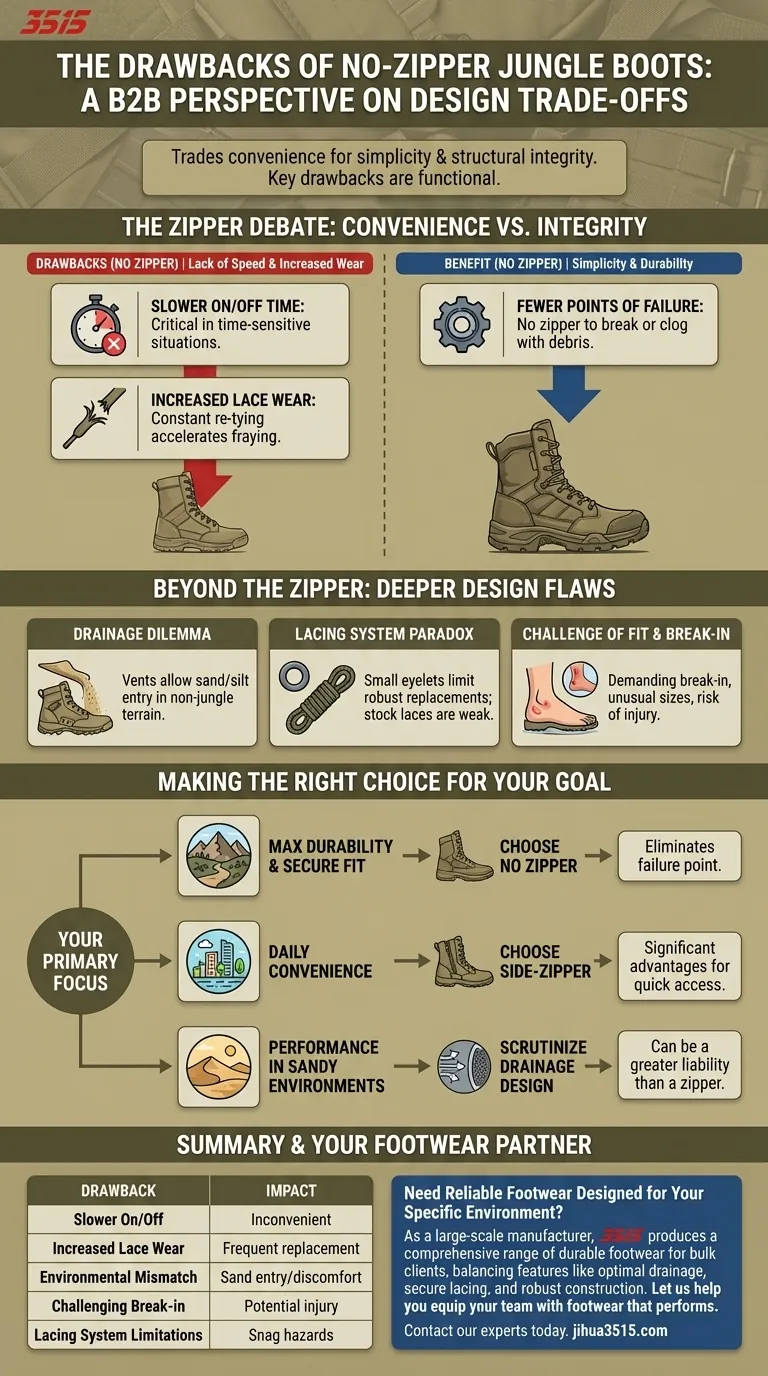At its core, a jungle boot without a side zipper trades convenience for simplicity and structural integrity. The primary drawbacks are functional: they are significantly slower to put on and take off, which increases daily friction and accelerates wear on the laces from constant re-tying. This lack of quick access can be a critical liability in situations demanding rapid gear changes.
The presence or absence of a side zipper is a symptom of a larger design choice. While a zipper offers undeniable convenience, focusing on it exclusively can distract from more critical jungle boot characteristics like drainage, fit, and material durability, which ultimately determine performance in the field.

The Zipper Question: Convenience vs. Simplicity
The debate over side zippers hinges on a fundamental trade-off. Understanding both sides is key to seeing the bigger picture of boot design.
The Clear Disadvantage: Lack of Speed
A traditional lace-up boot simply takes more time. In scenarios where you need to quickly don or doff your footwear—such as in an urban environment or during an alert—the lack of a zipper is a tangible inconvenience.
The Hidden Cost: Increased Wear
Without a zipper, the only way to get a secure fit is to repeatedly tighten and loosen the laces. This constant friction causes laces to fray and wear out much faster, often requiring replacement with more durable alternatives like paracord.
The Benefit of Simplicity: Fewer Points of Failure
The primary advantage of a no-zipper design is its robustness. A zipper is a mechanical component with teeth that can get clogged with mud, sand, or debris. A catastrophic zipper failure can render a boot useless, a risk that a traditional lace-up boot does not have.
Beyond the Zipper: Deeper Flaws to Consider
Focusing only on the zipper overlooks other, potentially more significant, drawbacks inherent in many jungle boot designs. These issues will impact performance regardless of how you get the boot on your foot.
The Drainage Dilemma
Jungle boots feature drainage vents near the sole to quickly expel water. While effective in wet jungles, these same vents become a major liability in sandy or marshy terrain, allowing fine sand and silt to enter the boot, which can cause severe discomfort and foot damage.
The Lacing System Paradox
Many jungle boots suffer from a poorly integrated lacing system. Stock laces are often weak and require immediate replacement. However, the eyelets and fittings are frequently too small for robust replacements like paracord, making the tensioning system ineffective and creating snag hazards on vegetation.
The Challenge of Fit and Break-in
Jungle boots are notorious for their demanding break-in period. They often come in unusual sizes and require extensive testing in varied terrain, especially while carrying a load, to ensure they fit correctly and don't cause injury.
Understanding the Trade-offs
Making an informed choice requires acknowledging the compromises inherent in any specialized gear.
Durability vs. Accessibility
A zipper is a clear point of failure. By choosing a boot without one, you are prioritizing long-term durability and reliability over the convenience of quick access.
Environmental Mismatch
The classic jungle boot is a specialized tool. Using it outside its intended environment, such as a desert, can introduce new problems like sand infiltration that are far more detrimental than the inconvenience of lacing up.
The "Boot as a System" Mentality
Viewing the boot as a single product is a mistake. Its performance depends on a system that includes high-quality replacement laces, appropriate socks, and the user's willingness to endure a lengthy break-in period. A failure in any of these areas compromises the entire system.
Making the Right Choice for Your Goal
Your decision should be guided by your primary use case and tolerance for potential failure points.
- If your primary focus is maximum durability and a secure fit for rugged terrain: Choose a boot without a zipper to eliminate a key point of failure and ensure a consistent, tight fit.
- If your primary focus is daily convenience for urban or clean environments: A side-zipper model offers significant advantages for quick on-and-off access where debris is not a major concern.
- If your primary focus is performance in sandy or silty environments: Scrutinize the drainage vent design above all else, as this feature can be a greater liability than the presence or absence of a zipper.
Ultimately, the most reliable boot is the one whose total design aligns with the specific demands of your environment.
Summary Table:
| Drawback | Impact |
|---|---|
| Slower On/Off Time | Inconvenient for rapid gear changes; critical in time-sensitive situations. |
| Increased Lace Wear | Constant re-tying causes laces to fray faster, requiring more durable replacements. |
| Potential for Environmental Mismatch | Drainage vents can allow sand/silt entry in non-jungle terrain, causing discomfort. |
| Challenging Break-in Period | Requires extensive testing under load to ensure proper fit and prevent injury. |
| Lacing System Limitations | Stock laces are weak; eyelets may be too small for robust replacements like paracord. |
Need Reliable Footwear Designed for Your Specific Environment?
As a large-scale manufacturer, 3515 produces a comprehensive range of durable footwear for distributors, brand owners, and bulk clients. Our production capabilities encompass all types of boots, ensuring you get the right balance of features—like optimal drainage, secure lacing systems, and robust construction—without unnecessary points of failure.
Let us help you equip your team with footwear that performs.
Contact our experts today for a consultation to discuss your specific needs and volume requirements.
Visual Guide

Related Products
- Durable Military Combat Boots with Water Drainage for Wholesale & OEM
- Wholesale Waterproof Tactical Boots Custom Suede & High-Traction Soles
- Durable Leather Tactical Boots Wholesale & Custom Manufacturing for Brands
- Wholesale Lightweight Tactical Boots with Dial Closure OEM & Bulk Orders
- Durable Leather High-Ankle Tactical Boots for Wholesale & Custom Manufacturing
People Also Ask
- How can a shiny finish be achieved on military boots? A Step-by-Step Guide to a Mirror Shine
- How do luxurious ostrich leather shoes differ from traditional dress shoes? A Guide to Texture & Comfort
- What has been the global recognition of fabric for over 30 years? Industry's Trusted Benchmark for Durability
- What replaced jungle boots in the US military? The Shift to Tan Suede Combat Boots
- What are the key features of the new Army Jungle Combat Boot? A Breakdown for Hot & Wet Environments



















